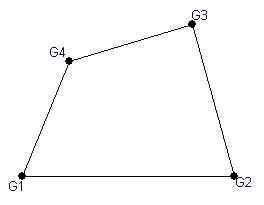PSHEAR |

|

|

|

|
|
PSHEAR |

|

|

|

|
Bulk Data Entry
PSHEAR – Shear Panel Property
Description
Defines the properties of a shear panel.
Format
(1) |
(2) |
(3) |
(4) |
(5) |
(6) |
(7) |
(8) |
(9) |
(10) |
PSHEAR |
PID |
MID |
T |
NSM |
F1 |
F2 |
|
|
|
|
Field |
Contents |
PID |
Unique shear property identification number. (Integer > 0) |
MID |
Material identification number of a MAT1 entry. (Integer > 0) |
T |
Thickness of shear panel. (Real ≠ 0.0) |
NSM |
Nonstructural mass per unit area. (Real) |
F1 |
Effectiveness factor for extensional stiffness along edges 1-2 and 3-4. Default = 0.0 (Real > 0.0) |
F2 |
Effectiveness factor for extensional stiffness along edges 2-3 and 1-4. Default = 0.0 (Real > 0.0) |
| 1. | The effective extensional area is defined by means of equivalent rods on the perimeter of the element. If F1 < 1.01, the areas of the rods on edges 1-2 and 3-4 are set equal to: |

where PA is the panel surface area (half the vector cross product area of the diagonals) and L12 and L34 are the lengths of sides 1-2 and 3-4. Thus, if F1 = 1.0, the panel is fully effective for extension in the 1-2 direction. If F1 > 1.01, the areas of the rods on edges 1-2 and 3-4 are each set equal to (0.5 x F1 x T).

Extensional Area for Shear Panel
Thus, if F1 = 30, the effective width of skin contributed by the panel to the flanges on edges 1-2 and 3-4 is equal to 15T. The significance of F2 for edges 2-3 and 1-4 is similar.
| 2. | Poisson's ratio coupling for extensional effects is ignored. |
| 3. | This card is represented as a property in HyperMesh. |
See Also: